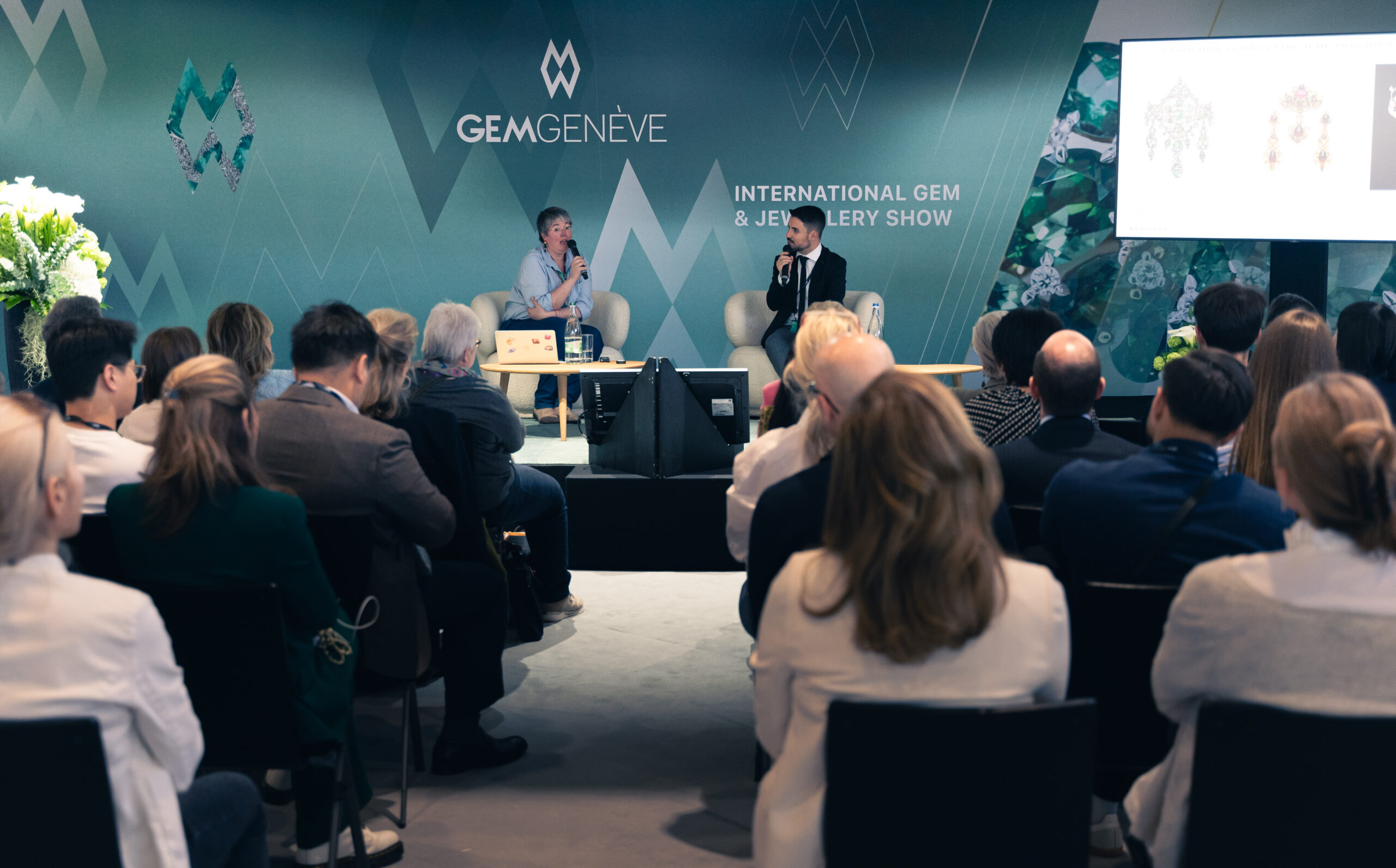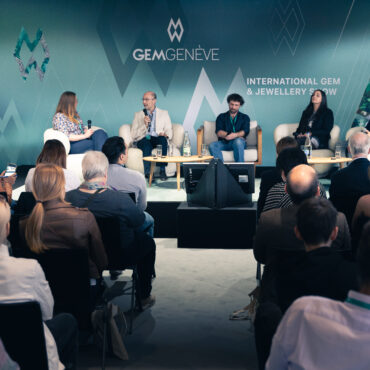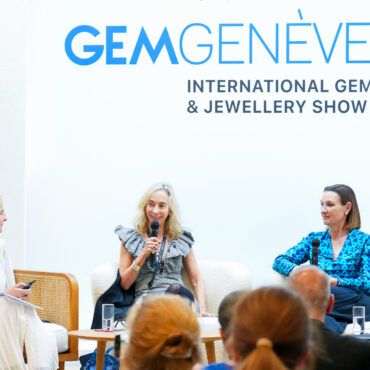Bulgari’s Influence
From the mid-20th century onwards, Bulgari played a pivotal role in reviving the cabochon cut, making it a signature element of the Maison. Moving away from traditional French designs that prioritised faceted gemstones and intricate settings, Bulgari embraced bold colours, large cabochon cuts, and yellow gold. This shift marked the emergence of the “Italian school of jewellery,” characterised by harmonious colour combinations, volume, and a modern aesthetic.
Gislain Aucremanne highlighted several iconic Bulgari pieces featuring cabochon-cut gemstones. One notable example is the Serpenti necklace from 1969, which incorporates a cabochon sapphire set into the head of a snake. This design not only echoes the etymology of “cabochon,” derived from the French word “caboche” meaning “head,” but also symbolises protection and wisdom. Another is a bracelet from 1954, adorned with cabochon sapphires and “bubbles” of rubies, emphasising volume and the bold use of colour. Bulgari’s designs, characterised by their daring combinations and architectural influences, redefined jewellery aesthetics.
Historical Context
The cabochon cut, one of the oldest techniques in the lapidary arts, dates back over 4,000 years. Ancient civilisations such as Egypt, Greece, and Rome appreciated this method for its ability to highlight a gemstone’s natural beauty and colour.
In ancient Egypt, cabochons featured prominently in regal jewellery. For example, a gold bracelet from the treasure of Pharaoh Ramses II showcases a central lapis lazuli cabochon. Lapis lazuli, symbolising the gods’ hair and the night sky, was polished to a smooth dome to enhance its celestial allure.
In Greece and Rome, cabochons were similarly esteemed. Greeks crafted armlets adorned with garnet cabochons, believing in their protective qualities. Meanwhile, Roman jewellery incorporated cabochons into earrings and brooches, with emeralds and amethysts emphasising the aesthetic harmony between metalwork and gemstones. The rounded, polished surfaces of cabochons amplified their colour and texture, ensuring comfort and durability.
During the Middle Ages, cabochons adorned religious artefacts and royal regalia. The Imperial Crown of the Holy Roman Empire is embellished with cabochon-cut gemstones, symbolising divine authority. The simplicity of the cabochon cut allowed for the use of fragile stones like emeralds, which were difficult to facet due to their inclusions and brittleness. However, with the advent of faceting techniques in the 14th and 15th centuries, cabochons fell out of favour as faceted cuts became synonymous with luxury and brilliance.
Technical Craftsmanship
Creating a perfect cabochon requires remarkable technical mastery. Unlike faceted stones, cabochons rely on their inherent colour and optical phenomena such as asterism (star effects) and chatoyancy (cat’s eye effect). Achieving these effects involves several steps that demand precision and expertise.
Opaque to translucent gemstones, often with unique inclusions or optical effects, are selected as ideal candidates for cabochons. Lapidaries then shape the gemstone into a dome with a flat base, polishing it to a reflective surface. Proper orientation during cutting enhances phenomena like asterism, as seen in star sapphires, where rutile needles create a striking star pattern under light. Marie Chabrol emphasised that achieving a symmetrical, well-proportioned cabochon requires an in-depth understanding of the gemstone’s material properties and the cutter’s artistic vision. The craftsmanship involved is both a science and an art, demanding technical expertise and a keen eye for aesthetics.
Revivalist Movements and Modern Innovations
The cabochon’s resurgence owes much to revivalist movements that sought inspiration from historical designs. In 19th-century Rome, the Castellani family, inspired by archaeological finds, created jewellery that embraced ancient techniques, including cabochon cutting. Their work bridged historical authenticity with contemporary design, influencing subsequent trends.
From the mid-20th century, Bulgari’s designs re-established the cabochon as a cornerstone of high jewellery. Iconic pieces like Elizabeth Taylor’s 65-carat Burmese sapphire pendant highlight the enduring appeal of the sugarloaf cabochon, a variation with a high dome and four symmetrical sides tapering to a point. This cut, inspired by the molded sugar shapes of the 17th century, combines the cabochon’s smooth curves with subtle facets, enhancing the gemstone’s depth and vibrancy.
Modern cabochons also take on unconventional forms, such as freeform cabochons shaped to fit a gemstone’s natural contours. Tubular and triangular cabochons add diversity, allowing designers greater creative freedom. These contemporary interpretations highlight the adaptability of the cabochon, making it a timeless choice for both traditional and avant-garde designs.
Artistic Effects and Cultural Influences
Cabochons enable jewellers to experiment with light, colour, and form, often creating mosaic-like patterns reminiscent of stained-glass windows. For instance, a necklace featuring cabochon citrines with hues evoking Roman sunsets demonstrates how this cut transforms natural phenomena into wearable art. The way cabochons capture and diffuse light adds depth and dimension to jewellery, giving it a sculptural quality.
The influence of Indian jewellery, particularly Mughal designs, is evident in the cabochon’s aesthetic evolution. Paolo Bulgari acknowledged India’s role in shaping European jewellery, stating, “India has given us a lot; all the colours of its arts and architecture are part of our inspiration.” This influence manifests in Bulgari’s 1965 earrings, which incorporate cabochon emeralds, rubies, and sapphires in designs inspired by traditional Indian turban ornaments. The bold use of colours and motifs underscores a deep connection between Eastern and Western aesthetics.
The Enduring Allure of the Cabochon
The cabochon cut epitomises a harmonious blend of historical tradition, technical craftsmanship, and artistic expression. From ancient treasures to contemporary masterpieces, it continues to captivate with its simplicity and elegance. By focusing on colour and form over brilliance, cabochons offer a timeless canvas for creative expression.
As Gislain Aucremanne and Marie Chabrol noted, the cabochon remains integral to maisons like Bulgari, symbolising artistry and innovation. The emotional resonance of iconic pieces, such as Elizabeth Taylor’s sapphire pendant, showcases how the cabochon connects personal stories with aesthetic brilliance. Whether in historical pieces or modern designs, the cabochon cut highlights gemstones’ unadulterated beauty, proving its place as an enduring element in the art of jewellery design.
Speakers:
Gislain Aucremanne (Bulgari Heritage Curator Director)
Marie Chabrol (Gemmologist & Journalist)





